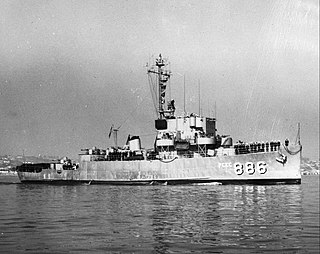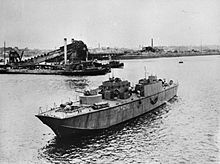The United States Navy, United States Coast Guard, and United States National Oceanic and Atmospheric Administration (NOAA) use a hull classification symbol to identify their ships by type and by individual ship within a type. The system is analogous to the pennant number system that the Royal Navy and other European and Commonwealth navies use.

The Landing Craft, Support (Large) were two distinct classes of amphibious warfare vessels used by the United States Navy (USN) in the Pacific and the Royal Navy in World War II. The USN versions, which were later reclassified Landing Ship Support, Large, also performed radar picket duty and fire fighting.

The Shinyo were Japanese suicide motorboats developed during World War II. They were part of the wider Japanese Special Attack Units program.

The Landing Craft Infantry (LCI) were several classes of landing craft used by the Allies to land large numbers of infantry directly onto beaches during World War II. They were developed in response to a British request for seagoing amphibious assault ships capable of carrying and landing substantially more troops than their smaller Landing Craft Assault (LCA). The result was a small steel ship that could land 200 men, traveling from rear bases on its own bottom at a speed of up to 15 knots.
USS Buttress (PCE-878/ACM-4) was an auxiliary minelayer (ACM) in the United States Navy during World War II. This ship and USS Monadnock (ACM-10) were the only ACMs not previously U.S. Army mineplanters.

Commercial Iron Works was a manufacturing firm in Portland, Oregon, United States. Established in 1916, the company is best remembered today for its contribution to America's Emergency Shipbuilding Program during World War II.

Willamette Iron Works was a general foundry and machine business established in 1865 in Portland, Oregon, originally specializing in the manufacture of steamboat boilers and engines. In 1904, the company changed its name to Willamette Iron and Steel Works, under which name it operated continually until its close in 1990.

George Lawley & Son was a shipbuilding firm operating in Massachusetts from 1866 to 1945. It began in Scituate, then moved to Boston. After founder George Lawley (1823–1915) retired in 1890, his son, grandson and great-grandson upheld the business, which continued until 1945. Of the hundreds of ships built by the Lawleys, highlights include the yachts Puritan and Mayflower, respective winners of the 1885 and 1886 America's Cup.

The PCE-842-class patrol craft escort was a United States Navy (USN) ship class of submarine chasers designed during World War II. The PCE-842-class were the only vessels ever designated by the USN as the 'patrol craft escort' (PCE) type. The PCE design was derived from the 180-foot (55 m) Admirable-class minesweeper to complement the 173-foot (53 m) PC-461-class submarine chasers that were used for anti-submarine warfare (ASW) in coastal areas. At 185 feet long and 640 tons, the PCE is more than twice the displacement of the PC but with a less powerful engine also much slower; however, because of its larger size, the PCE was able to undertake longer-range tasks over PC-461-class vessels. The USN envisaged the PCE as enabling PCs and smaller vessels to undertake coastal patrols without being called-upon as often to perform open ocean and convoy escort duties, while simultaneously freeing-up some larger vessels - such as destroyer escorts and destroyers - from convoy ASW duties. The PCE-482-class had a standard crew complement of 99 officers and men. The class would ultimately see 68 total vessels built, serving with multiple navies around the world.

USS LCS(L)(3)-102 is an LCS(L)(3)-1 Class Landing Craft Support ship built for the United States Navy during World War II. The vessel was completed near the end of the war and saw brief service during the Battle of Okinawa. After the war, LCS(L)(3)-102 served in China before being decommissioned in 1946 and then transferred to Japan in mid-1953. Serving under the name JDS Himawari, the vessel remained in Japan until mid-1966 when she was transferred to Thailand, becoming the HTMS Nakha. In 2007, after being retired, the ship was returned to the United States to become a museum ship.

The Type B ship is a United States Maritime Administration (MARAD) designation for World War II barges. Barges are very low cost to build, operate and move. Barges were needed to move large bulky cargo. A tug boat, some classed as Type V ships, could move a barge, then depart and move on to the next task. That meant the barge did not have to be rushed to be unloaded or loaded. Toward the end of World War 2, some ships that had not been completed in time for the war were converted to barges. US Navy barges are given the prefix: YWN or YW. Due to shortage of steel during World War II, concrete ship constructors were given contracts to build concrete barges, with ferrocement and given the prefix YO, YOG, YOGN. Built in 1944 and 1945, some were named after elements.

The Type V ship is a United States Maritime Commission (MARCOM) designation for World War II tugboats. Type V was used in World War II, Korean War, and the Vietnam War. Type V ships were used to move ships and barges. Type V tugboats were made of either steel or wood hulls. There were four types of tugboats ordered for World War II. The largest type V design was the sea worthy 186-foot (57 m) long steel hull, V4-M-A1. The V4-M-A1 design was used by a number of manufacturers; a total of 49 were built. A smaller steel hull tugboat was the 94-foot (29 m) V2-ME-A1; 26 were built. The largest wooden hull was the 148-foot (45 m) V3-S-AH2, of which 14 were built. The smaller wooden hull was the 58-foot (18 m) V2-M-AL1, which 35 were built. Most V2-M-AL1 tugboats were sent to the United Kingdom for the war efforts under the lend-lease act. The Type V tugs served across the globe during World War II including: Pacific War, European theatre, and in the United States. SS Farallon, and other Type V tugs, were used to help built Normandy ports, including Mulberry harbour, on D-Day, 6 June 1944, and made nine round trips to Normandy to deliver Phoenix breakwaters.

USS YOG-42 was a gasoline barge built by Concrete Ship Constructors, in National City, California. She was launched on March 23, 1943. Acquired by the United States Navy on May 23, 1943. She was assigned to the Asiatic-Pacific Theater, and survived the war. Re-designated YOGN-42 in May 1946, she was struck from the Naval Register on August 15, 1949. Sometime the next year, she was intentionally beached on the north coast of Lānaʻi in the Hawaiian Islands.

Splinter fleet or Splinter navy was a nickname given to the United States wooden boats used in World War II. The boats served in many different roles during the war. These boats were built in small boatyards on the West coast and East coast, Great Lakes and the Gulf of Mexico. They could be built quickly, in just 60 to 120 days. Most of the boats were built by boatyards that already had the tools and knowledge from building yachts, sailboats and motor boats. Many were built by craftsmen in family-owned small businesses. Under the Emergency Shipbuilding Program and War Shipping Administration contracts went out to over fifty boatyards across the country. The boats were built for the US Navy, the United States Army Air Forces, United States Coast Guard, and US Army. Some of the wooden boats went to Allied nations on the Lend-Lease program.

USS Banning (PCE-886) was a PCE-842-class patrol craft for the United States Navy during World War II.




















